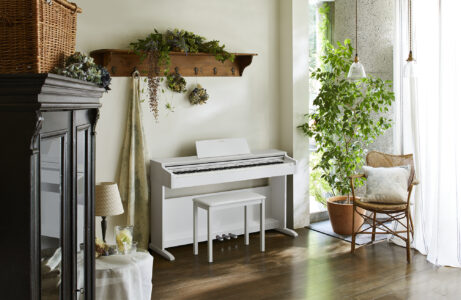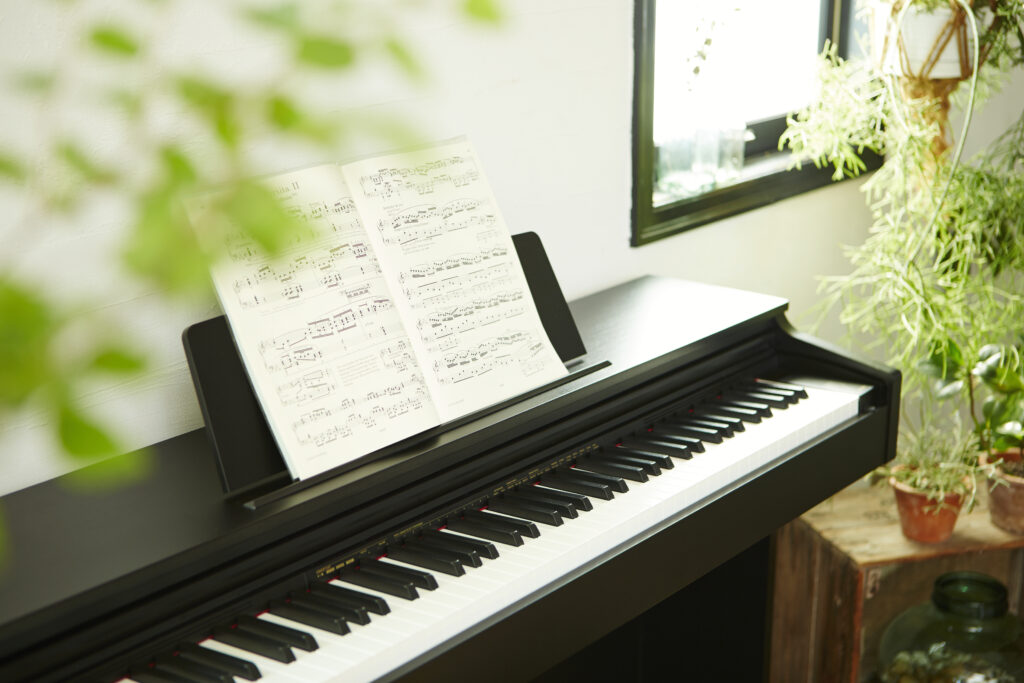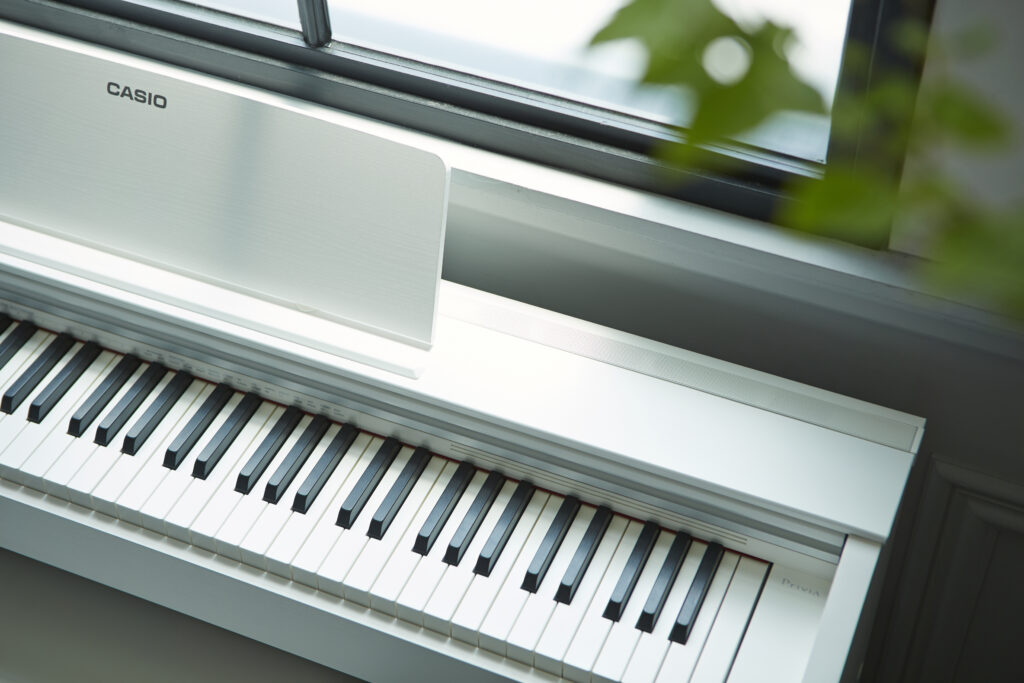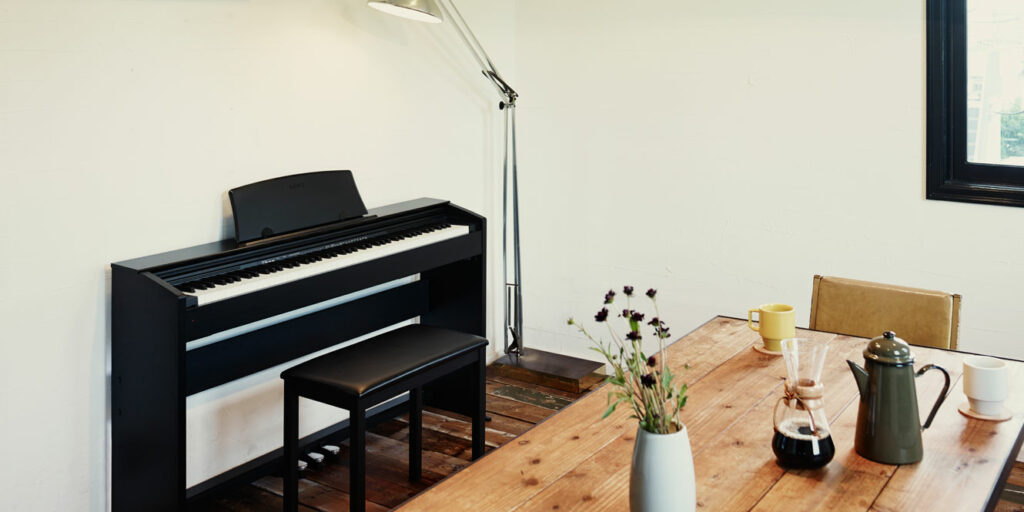History of Casio Pianos
Casio began as a small subcontractor that made microscope parts and gears. Over the years, Casio began to diversify, inventing a compact electric calculator in 1954. This further lead to diversification into other areas – namely, musical instruments.
In 1980, the first Casiotone keyboard was released. This began Casio’s history with pianos and other instruments. They continued to release electronic keyboards and synthesisers throughout the ’80s. In 1986, they released a sampler, able to capture any sound and play it.
Casio also released the DH-100 digital horn in 1988, an electronic wind instrument that was easy to play. In 2003, the Casio Privia PX-100 was released. This was the first instrument Casio designed to emulate the sound and feel of a grand piano, while also being affordable and compact enough to fit in someone’s home.
 Casio has continued to expand its piano line, and now sells pianos that suit everyone’s needs. From compact pianos for home practice, to full hybrid electric pianos. However, with so many to choose from, how do you know which fits your needs the best?
Casio has continued to expand its piano line, and now sells pianos that suit everyone’s needs. From compact pianos for home practice, to full hybrid electric pianos. However, with so many to choose from, how do you know which fits your needs the best?
An issue many people find with shopping for pianos is that brands will release many different pianos in different ranges at varying price points. This makes it extremely confusing to find the right piano, as they often have similar features and minor differences.
This guide will explain the differences and similarities between the Privia and Celviano ranges and which might be right for you.
PX 770 vs AP 270
The Looks
The first two pianos we will be comparing are the Privia PX 770 and the Celviano AP 270. At a first look, they both appear very similar. The PX 770 has a more minimal and simplistic look, whereas the AP 270 has a more traditional upright style of design.
If you were looking for a piano to play the aesthetic role in your home of an acoustic upright piano, then the AP 270 would be a great choice. If you wanted a more space-saving piano, then the PX 770 would be a better option.
The Feel
Both pianos have 88 plastic keys with an ivory touch finish. This mimics the feel of ivory and will make acoustic piano players feel more at home. The Privia and Celviano pianos also feature the same scaled hammer action. The scaled hammer action means there is more weight behind the keys on the bass notes than the higher notes, replicating the heavier hammers needed for bass strings in an acoustic piano.
Each piano also features a tri-sensor system. This makes for a more accurate response from the keys and a better feel when playing repeated notes. This will make experienced pianists happy as it provides a more traditional acoustic feel.

The Sound
Both instruments use Casio’s Acoustic and Intelligent Resonator (AiR) sound source to capture and reproduce the sound of an acoustic piano. The increased memory on these models allows for longer sampling duration and enhanced waveform data quality.
The AP 270 comes equipped with 22 sounds and the PX 770 has 19. The AP 270 has an extra grand piano included. The first piano which features on both the Privia and the Celviano is a concert grand, best suited to classical playing. The second piano which is only on the AP 270 is a more intimately recorded grand that will fit right in with pop and jazz music.
The same speaker system is used on both models, comprising of two 12 cm speakers. These sound great and reproduce the sound very well. The PX 770 has a maximum polyphony of 128 and the AP 270 has a polyphony of 192. Both pianos are great for general piano playing as a result, with the Celviano being the better option if you like to use a lot of sustain pedal and many-note chords or layered timbres.
However, unless you specifically are looking for the extra polyphony, most people would be fine with the 128-note polyphony of the Privia.
The Verdict
Overall, these pianos are extremely similar in sound. The same technology powers both pianos and the only real difference is the extra grand piano sounds in the Celviano model. If you feel like you would benefit from the extra choice in tone and extra notes in the polyphony, then this would be the best choice for you.
These pianos are very similar as noted in the comparison. As the differences are minor, you will probably need to consider whether the higher polyphony matters to you at all.
PX 870 vs AP 470
The Looks
The next two pianos are the PX 870 and the AP470. Both of these represent a slight increase in price and features from both the Casio lines. Much like the previous comparison, it is apparent that these pianos are extremely similar. The largest difference may in fact be the overall looks of these pianos.
The Privia piano, once again, represents a more minimal design with less overall physical, and visual space taken up in the room. This piano is more substantial in size when compared to the PX770. However, the Celviano looks more like a traditional upright piano, but takes up more space in your room.
Like with the previous two pianos, you would need to consider the amount of space you have in your practice space and the prominence you wish for your piano to have in the room.
The Feel
These Pianos feature the same tri-sensor keys as the previous two do. As well as the ivory touch keys, which absorb moisture and prevent fingers from slipping. A feature of both pianos that makes these stand out from the previous models is the lid.
The lid simulation should be mentioned here, too. The physical motion of being able to raise the lid makes a difference, but the fact that the effect on the sound depends on how open it is adds that extra physical element to your playing experience.

The Sound
These pianos use the same AiR sound source as the other Casio pianos. However, both pianos have some upgrades to the sound which justifies their higher price. The first major feature is the string resonance simulator. This simulates the noise produced by the sympathetic resonance of the strings in an actual piano, adding a depth to your sound that is uncommon on electric instruments.
The Key Off simulator accurately replicates the acoustic effects of releasing keys quicker or slower. This is combined with the tri-sensor keys to really marry up the sound and feel of these pianos. The built-in tones are the same as the previous two, with the AP470 having 22 sounds and the PX870 having 19 tones.
The Verdict
When compared together, these instruments aren’t that much different from each other. They both improve on the previous models in their respective ranges in the same ways, with the improved simulations and the lid simulator. Like with the previous comparison, your decision over which one to buy will be down to your own personal preference as to which one will fit or look best in your space.
Which is Best for Me?
At first glance, it can be hard to tell the differences between these pianos. Even after investigating, it’s clear that the differences between many of these pianos are minor. This, in a way, makes the decision over which one to buy somewhat easier.

You can be assured that whichever piano you buy will provide a high-quality playing experience with great sound and feel. This means you can focus on how they will look and fit into your existing space. Perhaps you want to dedicate a lot of room space and attention to your piano. If that’s the case, then the Celviano pianos will most certainly suit you best.
However, if you move around a lot and would prefer a more space-saving piano that is somewhat easier to move, then the Privia range of pianos would be the best option for you.
Why not explore our full range of Casio Pianos below? There are plenty of bundles available to get you started straight away, with a piano stool and a pair of headphones included.













0 Comments